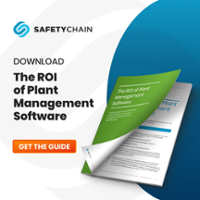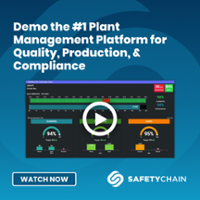Many leaders in process manufacturing plants know there’s a wealth of benefits to be had by going paperless. Yet, transforming processes which have been in place for years—or even decades—is a daunting prospect. Oftentimes, there’s a considerable gap between where facilities are now and where they want to be. Filling that gap is the end goal, since going paperless will allow you to leverage your plant’s data to drive measurable performance improvements and boost profitability. But where do you begin?
Here, we’ll dive into what it looks like to go digital, including the processes and technology it takes to get there.
The Myth of Process Manufacturing Lagging Behind
There’s a myth that circulates about process manufacturing: It’s widely believed that companies simply haven’t caught up with technology, and that they love binders and paperwork. In fact, it’s quite the opposite: Technology hasn’t caught up with how you work—until very recently.
Process manufacturing is inherently complex. The amount of data that flows through your facility—as well as the variety of sources, outputs, formats, and locations—make wrangling all that information a significant challenge. Of course, it’s more than challenging if you’re relying on paperwork; it’s near-impossible.
Consider the data sources your facility may have:
Operators
Non-Regulatory
ERP
Suppliers
Operations (SOPs)
Software (Inventory/WMS)
Customers
Labs
Regulatory
Equipment/PLCs
There are also many types of outputs required for using and making sense of all this data:
Forms/Checklists
Records
Inspections
Tasks
Reports
Verifications
Documents
Audits
Certifications
And, this information can come in a variety of formats, including paper, email, spreadsheets, and images. Tracking it down can be complex, too, as it might live in file cabinets or shared drives… or in a clipboard on an employee’s desk.
Leveraging Data
Clearly, it’s difficult to leverage your data if you can’t figure out where it’s going. Using paper, point solutions, or a combination of both impedes your visibility into all the information your plant is generating. But the pursuit of gaining control over your data is certainly worthwhile. Aside from your people and products, it’s the most valuable asset your company has.
Yet, for a company that has been doing things a certain way for years, this data challenge can be overwhelming. Fortunately, there’s a simple way to approach it.
Start by considering these three questions:
Can you capture the data you need right now?
In other words, are you able to gather it from the floor, customers, or other sources effectively?
Can you find data when you need it?
Do you have to go searching for information, or is it readily available?
Can you use that data?
This is where the magic happens—when you use data for powerful, real-time decision making that improves processes across your facility.
The Path Towards Digital Production Plans in Process Manufacturing
The path for going paperless takes the simplicity of the same three questions above and puts them into action.
1. Data Collection (Capture)
2. Data Management (Find)
3. Data Analysis (Use)
Here’s a closer look at each step.
Data Collection
When it comes to going digital, we often think about digitizing data collection. Where operators are collecting data on the plant floor, for instance, we might replace clipboards with tablets. This is an excellent place to start, but it’s only one aspect of the digitizing process.
You’ll also want to consider suppliers and customers: Is there a way to digitize the data you get from them as well? In most plants, there are four key areas for digitizing, along with a method that works best for each:
Operators (plant or field): Use mobile devices, such as tablets or phones, so these employees can scan and input data.
Suppliers & Customers: Use portals to share and collect information.
Regulatory, Non-regulatory, and Operations/Programs (SOPs): Use a web-based system to upload and update these programs.
Labs, Equipment/PLCs, ERP, Software (Inventory/WMS): Use integrations to ensure data can be collected from all sources and served up into a single source of truth – one convenient platform.
Data Management
After data is captured from all sources, the next step is managing it. This starts by determining who needs access to what information.
Operators, management, executives, customers, suppliers, and auditors all need access to different types of data. Yet, they don’t need access to everything. You’ll therefore need a mechanism for managing your plant’s data. Platforms with secure profiles, referred to as “role-based” access controls, ensure that each party only sees the information they need to see.
Additionally, different types of data call for specific modes of access:
For anyone taking care of forms, documents, and images, there should be records that are easy to access and sort through.
For parties responsible for compliance, non-compliance, and corrective actions, there should be simple sign-offs, with the ability to quickly filter data to support quick, efficient workflows.
For people managing
regulatory, non-regulatory, and internal audit efforts, there should be programs with data visualizations all in one spot.
Data Analysis
Finally, empower your teams to actually use your plant data by making insights simple to access and understand. For instance: With real-time access to compliance, quality, and
SPC data, operators could become more effective in their roles on the floor.
Managers and executives might benefit from higher-level overviews of shift, line, and plant performance, as well as metrics for throughput, yield, and
OEE.
For suppliers and customers, there should be an option for score carding, tracking shipping and receiving, and managing reporting and documents requirements.
All of this data should be served up in real-time business intelligence dashboards, making it easy to visualize information and make meaningful decisions that accelerate performance and boost profits.
Conclusion: Getting Started
To recap, the easiest way to address the data challenge in process manufacturing is to ask:
Can you capture data?
Can you find it?
Can you use it?
As you implement processes and technology to answer these questions, you’ll wind up with a well-aligned integration of data and technology throughout the entire plant management process, starting with your suppliers all the way through shipping and audits.
To get started, you might also ask yourself:
What do you want to do tomorrow that you couldn’t do today?
Who could your efforts help: operators, management, executives, or auditors?
How could it help in the areas of yield, throughput, productivity, or compliance?
By identifying the outcomes and benefits you want to achieve, you can refine your roadmap, establish critical
process manufacturing methodologies, and get started on a digital production plan that meets your company’s goals.
This is the core of what SafetyChain does: working with companies to achieve their goals through plant management software. Watch the quick video guide for planning out your plant’s approach to digital production
here.
